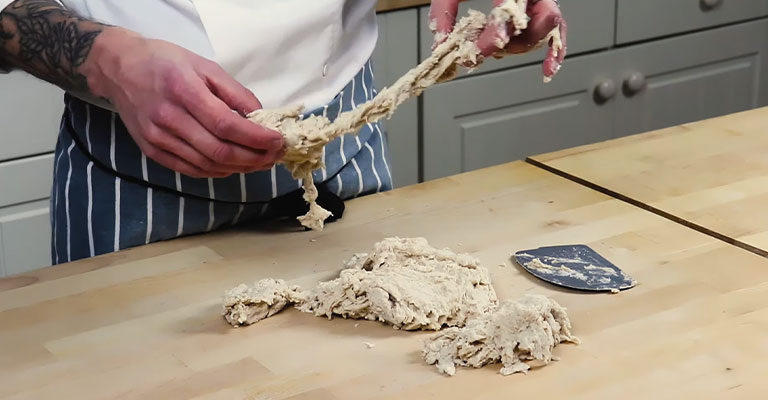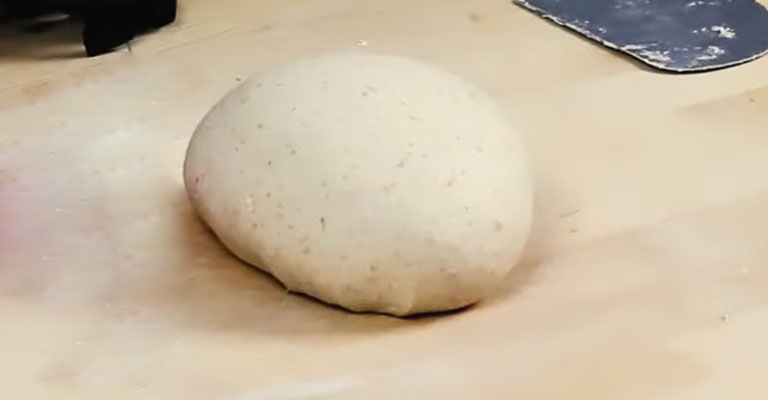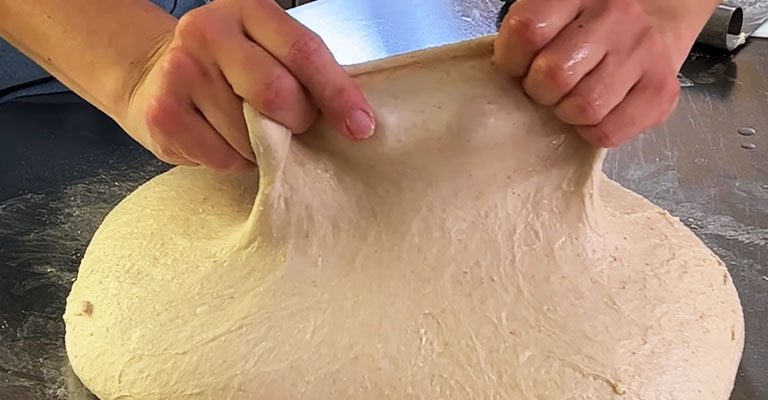Why Is My Sourdough Tearing? -Causes and Solutions
Sourdough bread, with its rustic charm and complex flavors, has captured the hearts of home bakers and culinary enthusiasts worldwide.
However, this beloved bread can sometimes present a frustrating challenge: tearing during preparation and baking.
The question “Why is my sourdough tearing?” often haunts those embarking on their sourdough journey.
The answer lies in the intricacies of gluten development, fermentation, hydration, and handling. This conundrum is a testament to the delicate balance of art and science in sourdough baking.
In this exploration, we delve into the common reasons behind sourdough tearing and offer solutions to help you create loaves that are not only delicious but beautifully intact.

Why Is My Sourdough Tearing?
When your sourdough bread tears or doesn’t hold its shape properly, it can be frustrating, especially after putting in the effort and time to create a beautiful loaf.
There are several reasons why this might happen, and understanding them can help you troubleshoot and improve your sourdough baking skills.
Here are some common reasons why your sourdough might be tearing:
Insufficient Gluten Development
Gluten is the backbone of a good loaf, providing the structure and elasticity necessary for a well-risen, well-textured bread.
When gluten isn’t given the time it needs to properly develop, either through kneading or a prolonged autolyze, the dough remains weak and unable to hold its shape. This often results in tearing, especially during shaping.
Over-Fermentation
Over-fermentation occurs when the dough is left to rise for an extended period. During this time, the yeast and bacteria consume most of the available sugars.
Consequently, the dough becomes slack and sticky, lacking the necessary structure for a well-formed loaf. This weakened structure leads to tearing as the dough struggles to hold its shape.
Under-Hydration
The hydration level of your dough significantly impacts its texture and structure. If the dough lacks sufficient moisture, it becomes dry and stiff.
This inhibits gluten development, rendering the dough crumbly and prone to tearing. Ensuring the right balance of flour and water is crucial for achieving a supple, workable dough.
Improper Shaping
Shaping is a critical step in the bread-making process. It’s where you build tension in the dough, creating the foundation for a well-risen loaf.
When shaping is rushed or not executed correctly, the dough lacks the necessary strength and structure. As a result, it struggles to hold its shape during proofing and baking, leading to tearing.
Inadequate Resting Periods
Resting periods are often underestimated, yet they play a vital role in both gluten development and flavor enhancement. Autolyse, for instance, allows the flour and water to interact and hydrate fully before other ingredients are added.
Cutting short or skipping these resting stages compromises the dough’s strength and texture, making it more prone to tearing.
High Hydration Dough
While high-hydration doughs can yield wonderfully open crumb structures, they require a different approach. The increased moisture content can make the dough more challenging to handle.
Extra care is needed during shaping to maintain its integrity and prevent tearing. Proper techniques, like folding, become even more crucial.
Incorrect Flour Type
The choice of flour significantly impacts gluten development. Different flours have varying protein contents, which directly affect the dough’s ability to form a strong structure.
When you’re working with low-protein flour, you might need to adjust your techniques to compensate for this lower gluten potential.
Inadequate Kneading or Folding
Kneading and folding are the primary methods for developing gluten. When these processes are rushed or not given enough attention, the gluten network remains underdeveloped.
Consequently, the dough lacks the necessary strength to hold its shape, leading to tearing during shaping and baking.
Poor Scoring Technique
Scoring serves a dual purpose: it allows the dough to expand in a controlled manner and creates an aesthetic pattern on the crust. However, improper scoring techniques can lead to issues.
A shallow cut might not provide enough room for expansion, while a deep cut might weaken the structure. Additionally, using a dull blade can result in tearing rather than controlled expansion.
Inadequate Oven Spring
Oven spring is the final burst of growth that occurs in the early stages of baking, caused by the rapid expansion of gases inside the dough.
When the oven isn’t preheated sufficiently or if there isn’t enough steam, the dough may not get the energy it needs to fully expand. This can result in a loaf that hasn’t risen properly, potentially leading to tearing.
Solutions for Preventing Tearing

Preventing tearing in your sourdough bread is crucial for achieving a beautifully risen, intact loaf.
Here are some solutions to help you overcome this challenge:
Proper Gluten Development
Ensure you allow enough time for gluten to develop. Knead your dough thoroughly or incorporate stretching and folding techniques during bulk fermentation.
Well-developed gluten provides the strength and elasticity needed to prevent tearing.
Careful Monitoring of Fermentation
Keep a close eye on your dough during the fermentation process.
Avoid over-fermentation by following a reliable schedule, which will help maintain the dough’s structure and prevent it from becoming too slack.
Maintain Adequate Hydration
Ensure the hydration level of your dough is appropriate. Balance the ratio of flour and water to create a workable dough.
A dough that’s too dry lacks the moisture necessary for proper gluten development and may tear during handling.
Master the Art of Shaping
Take your time when shaping your dough. Proper shaping builds tension within the dough, which is essential for a well-risen loaf. Practice your shaping techniques to ensure your dough is uniform and strong.
Respect Resting Periods
Respect resting periods like autolyse and bulk fermentation. These stages allow gluten development and flavor enhancement.
Skipping or shortening them can result in a weaker dough that tears more easily.
High Hydration Dough Management
When working with high-hydration dough, exercise extra caution.
Be gentle when handling the dough to prevent it from losing its shape. Using folding techniques during bulk fermentation can also help strengthen the dough.
Choose the Right Flour
Select flour with an appropriate protein content. Different flours have varying protein levels, which can impact gluten development. Opt for a higher-protein flour if you want a stronger dough that’s less likely to tear.
Thorough Kneading and Folding
Pay attention to kneading and folding. These techniques are essential for developing gluten. Dedicate time and effort to these stages to ensure your dough is strong and resilient.
Master Scoring Techniques
Practice your scoring techniques to create the perfect incisions on the surface of the dough.
A well-executed score allows for controlled expansion during baking, preventing irregular tearing and promoting an even rise.
Ensure Adequate Oven Spring
Preheat your oven properly and use steam to create the ideal environment for oven spring.
A hot oven and ample steam encourage the dough to expand evenly, reducing the chances of tearing during the final stages of baking.
Refined Baking Techniques to Prevent Tearing

Achieving a flawlessly risen, intact sourdough loaf requires mastery of various baking techniques.
Here are some refined methods to help you overcome the issue of tearing in your bread:
Mastering Gluten Development
Properly developed gluten is the cornerstone of a well-structured loaf.
Employ thorough kneading or incorporate techniques like stretch and fold during bulk fermentation. A robust gluten network provides the necessary strength and elasticity to prevent tearing.
Precise Fermentation Management
Vigilantly monitor your dough during fermentation. Avoid over-fermentation by adhering to a precise schedule.
This ensures the dough maintains its structure and doesn’t become overly slack, minimizing the risk of tearing.
Balanced Hydration Levels
Attaining the right hydration level is crucial. Strike a harmonious balance between flour and water to create a workable dough.
A dough that’s too dry lacks the necessary moisture for proper gluten development, potentially leading to tearing during handling.
Artful Shaping Techniques
Dedicate ample time to shaping your dough. Meticulous shaping builds tension within the dough, which is essential for a well-risen loaf.
Practice your shaping techniques to ensure uniformity and strength in your dough.
Respecting Resting Periods
Honor resting stages like autolyse and bulk fermentation. These intervals allow for optimal gluten development and flavor enhancement.
Skipping or truncating them can result in a weaker dough that’s more prone to tearing.
High Hydration Dough Handling
When working with high-hydration dough, exercise extra caution. Handle the dough gently to prevent it from losing its shape.
Implement folding techniques during bulk fermentation to fortify the dough’s structure.
Selecting the Right Flour
Opt for flour with an appropriate protein content. Different flours possess varying protein levels, which significantly impact gluten development.
Opting for a higher-protein flour yields a stronger dough less likely to tear.
Thorough Kneading and Folding
Pay meticulous attention to kneading and folding. These techniques are fundamental for gluten development.
Allocate sufficient time and effort to these stages to ensure your dough is robust and resilient.
Mastery of Scoring Techniques
Hone your scoring skills to create perfect incisions on the dough’s surface
A well-executed score allows for controlled expansion during baking, mitigating irregular tearing and promoting an even rise.
Ensuring Adequate Oven Spring
Preheat your oven thoroughly and utilize steam to create an optimal baking environment.
A hot oven and ample steam encourage the dough to expand uniformly, reducing the likelihood of tearing in the final stages of baking.
Troubleshooting Tearing Issues in Sourdough Baking
The goal of this section is to identify and address common factors contributing to tearing in sourdough bread.
By understanding these issues and implementing targeted solutions, you’ll be better equipped to achieve beautifully risen, intact loaves.
Let’s explore the key areas for troubleshooting:
The Dough is Too Sticky
- Possible Cause: Over-hydration or high water content in the recipe.
- Solution: Add a small amount of flour during kneading or shaping until the dough becomes more manageable.
Dough is Too Dry
- Possible Cause: Insufficient water or low hydration in the recipe.
- Solution: Gradually add small amounts of water while mixing until the dough reaches the desired consistency.
Bread is Dense and Heavy
- Possible Cause: Insufficient fermentation or proofing time.
- Solution: Allow the dough to ferment for a longer period, ensuring it has doubled in size before shaping and proofing.
Bread Has a Gummy Texture
- Possible Cause: Under-baking or insufficient oven time.
- Solution: Bake the bread for an extended period until it achieves a golden-brown crust and sounds hollow when tapped on the bottom.
Lacks Oven Spring
- Possible Cause: Insufficient gluten development or over-proofing.
- Solution: Improve gluten development through thorough kneading or folding. Avoid over-proofing by monitoring the dough closely during fermentation.
Bread Has an Overly Tart Flavor
- Possible Cause: Prolonged fermentation or excessive use of a sourdough starter.
- Solution: Shorten the fermentation time or reduce the amount of starter used in the recipe.
Uneven Crumb Structure
- Possible Cause: Inadequate shaping or scoring techniques.
- Solution: Practice shaping and scoring to create even tension in the dough, allowing for uniform expansion during baking.
Bread Collapses After Shaping
- Possible Cause: Insufficient gluten development or over-proofing.
- Solution: Strengthen gluten development through thorough kneading or folding. Avoid over-proofing by monitoring the dough closely.
Dough Doesn’t Rise During Proofing
- Possible Cause: Weak starter or inactive yeast.
- Solution: Ensure your starter is healthy and active. Use warm water to activate the yeast and allow for sufficient fermentation.
Excessive Tearing During Shaping
- Possible Cause: Insufficient gluten development or rough handling.
- Solution: Ensure gluten is well-developed through thorough kneading or folding. Handle the dough gently during shaping.
FAQs
What causes my sourdough to tear during shaping?
Tearing during shaping can occur due to insufficient gluten development in the dough.
Can the choice of flour impact sourdough tearing?
Yes, the type of flour you use can affect gluten development, potentially leading to tearing.
Is over-fermentation a reason for my sourdough to tear?
Yes, over-fermentation can result in a slack dough that’s more likely to tear during handling.
What can I do to prevent sourdough tearing when working with high-hydration dough?
When working with high-hydration dough, practice gentler handling techniques to prevent tearing.
Can poor scoring techniques lead to sourdough tearing during baking?
Yes, improper scoring techniques can lead to tearing, as well as uneven expansion during baking.
To Recap
In the world of sourdough baking, understanding why your loaves tear is a vital step toward mastering the art.
Whether it’s due to insufficient gluten development, over-fermentation, improper hydration, or missteps during shaping, pinpointing the issue is the first step to a solution.
By fine-tuning your techniques, from kneading to shaping and scoring, you can prevent tearing and create beautifully risen, intact loaves.
Additionally, choosing the right flour and respecting resting periods will contribute to dough strength and structure.
Sourdough baking is a delightful journey, and as you troubleshoot and refine your skills, you’ll find that the joy of a perfect loaf is well worth the effort.
